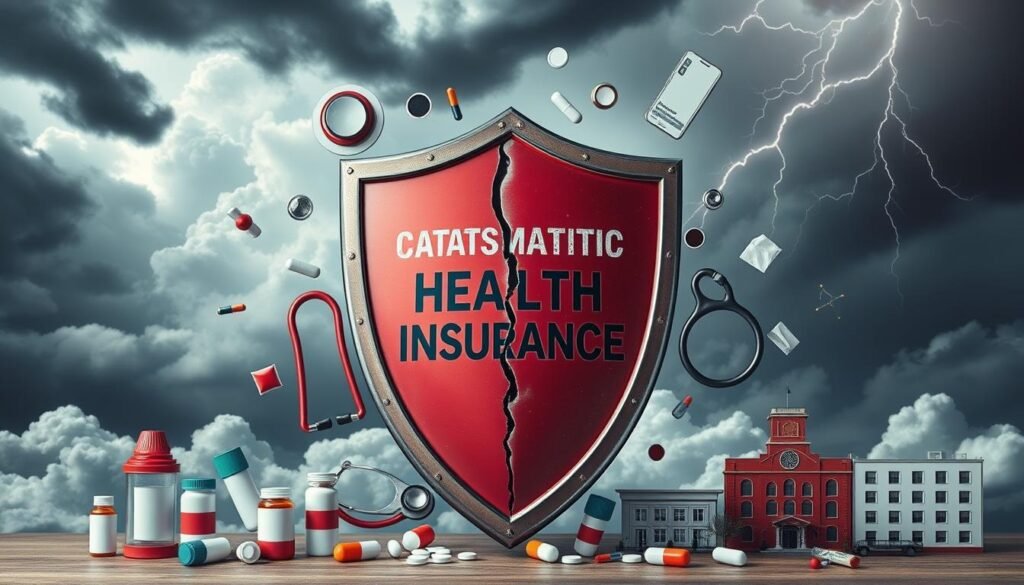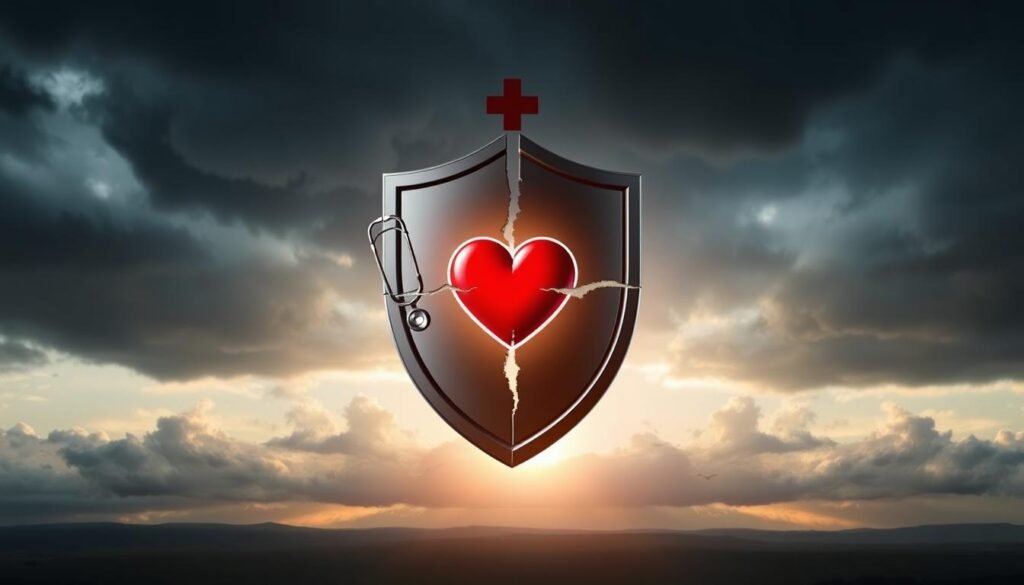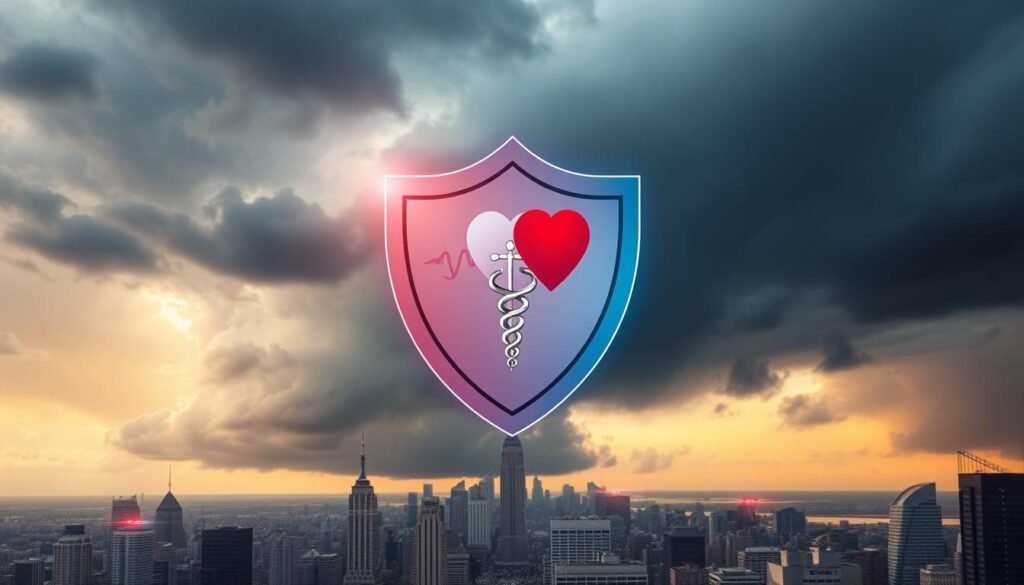Table of Contents
ToggleChoosing the right emergency health insurance plan is key to protecting yourself from unexpected medical bills. These plans, also known as catastrophic health insurance, cover major medical events and emergencies. They also offer preventive care services. These plans have low monthly costs but high deductibles. This makes them a good choice for healthy people who don’t need frequent medical care.
To pick the best plan, it’s important to know about eligibility, benefits, and limits. You should also understand how to sign up. This knowledge helps you make a smart choice.
Key Takeaways
- Emergency health insurance, or catastrophic health insurance, provides coverage for major medical events and emergencies.
- These plans have low monthly premiums but high deductibles, making them an affordable option for healthy individuals.
- Understanding the eligibility requirements, benefits, and limitations of emergency health insurance is crucial when choosing the best plan.
- The enrollment process may involve applying for hardship exemptions or selecting a plan through the Health Insurance Marketplace.
- Carefully evaluating your anticipated healthcare needs and out-of-pocket costs can help you choose the right emergency health insurance plan.
What is Emergency Health Insurance?
Emergency health insurance, also known as catastrophic health insurance, helps cover unexpected medical emergencies and major events. These plans have low monthly premiums but high deductibles. This means you’ll pay a lot out-of-pocket before your insurance coverage kicks in.
After you’ve paid the deductible, catastrophic plans cover many essential health benefits. They also offer a financial safety net during a medical crisis. It’s important to know how emergency health plans work and how they’re different from regular health insurance. This knowledge helps you choose the right coverage for you.
Defining Catastrophic and Emergency Coverage
Catastrophic health insurance is for unexpected and high-cost medical events. This could be hospital stays, emergency surgeries, or serious illnesses. These plans have lower monthly premiums but higher deductibles than regular health insurance plans.
Understanding the Role of Emergency Health Plans
Emergency health insurance plans offer a financial safety net for unexpected health costs or major medical events. They help cover the cost of emergency medical care. This ensures people have access to the essential health benefits they need in a crisis.
“Catastrophic health insurance plans are designed to provide coverage for unexpected and high-cost medical events, such as hospitalization, emergency surgeries, or serious illnesses.”
Who Qualifies for Emergency Health Insurance?
Emergency health insurance, also known as catastrophic health plans, helps cover unexpected medical costs. It’s for people facing a medical emergency or health crisis. Only certain groups can get these plans.
Eligibility Requirements for Catastrophic Plans
People under 30 are the main group that can get catastrophic health insurance. They are usually healthier and want cheaper coverage. Also, anyone can get these plans if they qualify for an exemption under the Affordable Care Act.
Exemptions and Hardship Qualifications
- Hardship Exemption: This is for people who have gone through big financial troubles. This could be bankruptcy, being homeless, or losing a family member.
- Affordability Exemption: If you make too little money to buy health insurance, you might get this exemption. It lets you sign up for a catastrophic health plan.
It’s important to know the rules and exemptions for emergency health insurance. This helps decide if it’s the best choice for your health needs.
Key Benefits of Emergency Health Insurance Plans
Choosing a healthcare plan is important. Emergency health insurance, or catastrophic health plans, offer a big advantage with their low monthly premiums. These plans help cover major medical costs. They’re a good choice for healthy people who don’t expect to visit the doctor often.
Low Monthly Premiums
Catastrophic health plans have lower monthly costs than other health insurance types. This is great for young, healthy people or those watching their budget. They can protect themselves from the cost of sudden medical bills without paying high premiums.
Coverage for Essential Health Benefits
Even with lower costs, catastrophic health insurance must cover the same essential benefits as other Affordable Care Act plans. This includes things like check-ups, screenings, and some vaccinations. With a high deductible, plan holders still get these important services without extra cost.
It’s key to understand the savings and full coverage of emergency health insurance plans. This helps when picking the best plan for your health needs and budget.
Also Read : What Should You Look For In A Business Credit Card Offers?
Limitations of Emergency Health Insurance

Catastrophic health insurance plans are affordable and cover essential health benefits. But, they have big drawbacks. The main issue is the high deductible. This means you must pay a lot out-of-pocket before your insurance helps.
Also, catastrophic plans may not cover non-emergency care. This includes regular doctor visits or managing chronic conditions. So, they’re not great for people who need a lot of medical care.
High Deductibles
Catastrophic health insurance is for unexpected, high-cost medical events. They have very high deductibles, often $8,000 or more for one person. So, you’ll pay a lot out-of-pocket before insurance covers your costs.
Limited Coverage for Non-Emergency Care
Catastrophic health insurance has a big limit on non-emergency care. They focus on big medical events like hospital stays or major surgeries. They might not cover routine doctor visits, preventive care, or managing chronic conditions well.
It’s important to know the trade-offs when picking an emergency health insurance plan. Catastrophic coverage is good for some, but not for everyone. It’s not the best for those needing more comprehensive coverage.
Also Read : How Can Real Estate Be Used As Loan Security?
Emergency Health Insurance Plans

When looking at catastrophic health insurance, it’s key to check out different health insurance plan options and their costs. Catastrophic health plans have different deductibles, monthly costs, and coverage. So, it’s important to look closely at each plan to see which one fits your needs and budget best.
Catastrophic health plans are great because they have low monthly premiums. This makes them a good choice for people who are usually healthy but want coverage for major medical events or emergencies. These plans also cover essential health benefits, so you can get the healthcare services you need.
Comparing Plan Options and Costs
To pick the right catastrophic health plan, check out the options on the Health Insurance Marketplace. This platform lets you look at and compare different health insurance plans. You can find plans that cover major medical events and emergencies easily.
| Plan Feature | Plan A | Plan B | Plan C |
|---|---|---|---|
| Deductible | $8,700 | $7,500 | $6,900 |
| Monthly Premium | $170 | $210 | $250 |
| Coverage for Essential Health Benefits | Yes | Yes | Yes |
| Coverage for Major Medical Events | Yes | Yes | Yes |
By looking at the deductibles, monthly costs, and what’s covered in different catastrophic health plans, you can choose the best one for your health costs and coverage needs. The Health Insurance Marketplace is a great place to check out and compare these health plans.
Also Read : How Does A Quick Loan Differ From A Traditional Personal Loan?
Factors to Consider When Choosing a Plan

Choosing an emergency health insurance plan requires careful thought about your healthcare needs and potential costs. This ensures you pick a plan that covers you well and protects your finances.
Assessing Your Healthcare Needs
First, think about if you might need emergency medical care or if you have ongoing health issues. This will show if a catastrophic plan with a high deductible but low premiums suits you. Or, if you need more coverage, a comprehensive plan might be better.
Healthy people who don’t visit the doctor often might be okay with a catastrophic plan. But, those who need regular care might prefer a plan with lower deductibles and better coverage for non-emergency services.
Considering Out-of-Pocket Costs
Also, think about the costs you might face, like the deductible, copayments, and coinsurance. It’s key to pick a plan that fits your budget. A catastrophic health plan covers less than a regular plan, so consider the cost vs. coverage balance.
By carefully thinking about your healthcare needs and costs, you can pick the right emergency health insurance plan. This plan will offer the right protection and financial support for you.
Also Read : Strategies For Loan Approval With Limited Credit History
Emergency Health Insurance Enrollment Process

Getting emergency health insurance, or catastrophic health plans, might seem hard. But, it’s important to know the steps. First, you need to see if you can get a hardship or affordability exemption under the Affordable Care Act (ACA). These exemptions let you get catastrophic plans, which are usually for people under 30.
Applying for Hardship Exemptions
To get an exemption, you must send in the right documents to the Health Insurance Marketplace. This exemption is for those facing tough times, like being homeless, going through domestic violence, or hit by a natural disaster. It’s key to gather the needed proof and fill out the application to get to catastrophic health insurance plans.
Selecting a Plan on the Health Insurance Marketplace
After getting an exemption or being under 30, you can pick a catastrophic health plan on the Marketplace. You’ll look at different plans and prices to find the best one for your budget and needs. Catastrophic insurance has lower monthly costs but high deductibles and limited coverage for non-emergency care. It’s important to know these trade-offs when picking your emergency health insurance.
| Plan Feature | Catastrophic Plan | Comprehensive ACA Plan |
|---|---|---|
| Monthly Premiums | Lower | Higher |
| Deductibles | Higher | Lower |
| Coverage for Non-Emergency Care | Limited | More Comprehensive |
Knowing how to enroll, including applying for exemptions and picking a plan on the Marketplace, is key. By doing the right steps, you can get the emergency health insurance that fits your needs and budget.
Also Read : Exploring The Career Path Of A Medical Lab Technologist
Pros and Cons of Emergency Health Insurance

Emergency health insurance, also known as catastrophic health plans, have good and bad points. On the plus side, these catastrophic health insurance plans have low monthly costs. This makes them a budget-friendly choice for healthy individuals who don’t expect to need much medical care. These plans are made to cover big medical bills, acting as a safety net for major medical expenses.
But, the high deductibles of these catastrophic health plans might not work well for people needing regular medical care. They have to pay a lot out-of-pocket before their coverage kicks in. Also, these plans might not cover non-emergency medical services well. This could be a problem for those looking for more all-around health coverage affordable.
- Low monthly premiums make catastrophic health insurance an affordable option for some.
- Plans are designed to protect against major medical emergencies and high costs.
- High deductibles can be a barrier for those needing regular medical care.
- Limited coverage for non-emergency services may be a disadvantage.
It’s important to know the good and bad of emergency health insurance before deciding if it’s right for you. Think about how it fits your health needs and budget. This way, you can make a smart choice about the catastrophic health plan’s value.
Also Read : Who Should Consider Getting Cyber Insurance?
Conclusion
Choosing the right emergency health insurance plan is crucial. You need to look at things like who can get it, what it covers, what it doesn’t, and how to sign up. These plans offer affordable coverage for sudden medical emergencies. They’re great for people who rarely visit the doctor.
But, they might not be the best for those with ongoing health issues or who need regular medical care. It’s important to know the good and bad about these plans. This way, you can pick the right one for your health and money needs.
Emergency health insurance can really help protect you from the cost of sudden medical problems. Just make sure to check the details of the plan. This ensures it fits your health needs before you decide.
FAQs
Q: What is catastrophic health insurance?
A: Catastrophic health insurance is a type of health insurance designed to provide coverage for worst-case scenarios, such as serious accidents or illnesses. It typically has a low monthly premium but a high deductible, meaning you pay more out-of-pocket before the insurance kicks in.
Q: How does a catastrophic health plan work?
A: A catastrophic health plan works by covering essential health benefits after you’ve met a high deductible. These plans are intended to protect you from very high costs in the event of a medical emergency or serious health issue while keeping premiums lower.
Q: What are the pros and cons of catastrophic health insurance?
A: The pros of catastrophic health insurance include lower monthly premiums and coverage for emergency care after the deductible is met. The cons include high out-of-pocket costs, limited coverage for primary care visits, and potential financial hardship if you face significant healthcare costs before your deductible is met.
Q: Who can enroll in a catastrophic health insurance plan?
A: Catastrophic health insurance plans are available to people under 30 and some low-income individuals who qualify for an exemption. These plans are specifically designed to meet the needs of those who want to protect themselves against high medical costs without paying for comprehensive coverage.
Q: What types of services are covered by catastrophic health coverage?
A: Catastrophic health coverage typically includes essential health benefits such as emergency services, hospitalization, and preventive services at no cost. However, routine medical care and primary care visits are often limited until the deductible is met.
Q: Can I buy catastrophic health insurance at any time?
A: You can buy catastrophic health insurance during the Open Enrollment Period or if you qualify for a Special Enrollment Period due to certain life events. Outside of these times, you may not be able to enroll in a catastrophic health plan.
Q: What should I consider before choosing catastrophic health insurance?
A: Before choosing catastrophic health insurance, consider your healthcare needs, potential out-of-pocket expenses, and whether you can afford the high deductible. Evaluate if this type of health insurance is the right choice for you based on your risk of needing medical care.
Q: What happens if I qualify for an exemption?
A: If you qualify for an exemption, you may be able to avoid the requirement to have health insurance or to pay a penalty. This can include individuals experiencing financial hardship or those who cannot find affordable coverage options.
Q: How can I meet my deductible with catastrophic insurance?
A: You can meet your deductible with catastrophic health insurance by incurring healthcare costs that are covered under the plan, such as emergency care or hospitalization. Once your deductible is met, the insurance company will begin to pay for covered services.





